Mata Vaishno Devi, also known as Trikuta, is a revered Hindu goddess worshipped in Katra, Jammu. And here we are presenting you 21 interesting facts about Mata Vaishno Devi.
Facts About Mata Vaishno Devi
Vaishno Devi is one of the most popular pilgrimage destinations in India. Let’s know the interesting facts about Mata Vaishno Devi, Katra.
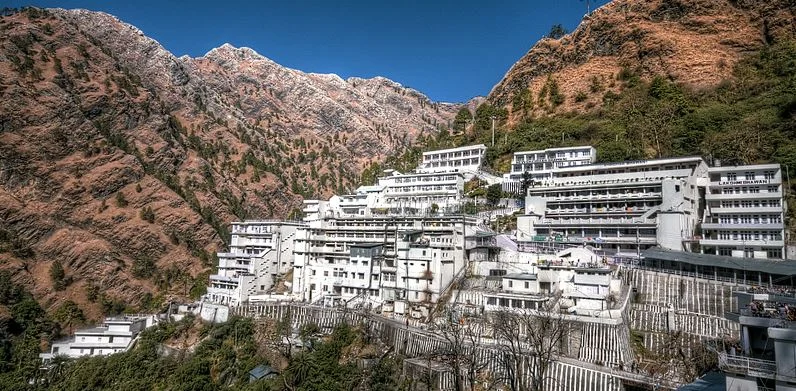
1. Legends & Historical Facts About Vaishno Devi
Mata Vaishno Devi is a revered Hindu pilgrimage site dedicated to the Hindu goddess Mata Vaishno Devi, a manifestation of divine feminine energy.
The first historical reference to Mata Vaishno Devi is from Mahabharat.
The epic Mahabharata makes the earliest mention of the Mother Goddess, which occurred during the fierce battle of Kurukshetra between the Pandavas and the Kauravas.
Seeking victory, Arjun, the eminent warrior among the Pandavas, followed Sri Krishna’s advice and sought the blessings of the Mother Goddess.
While worshiping Vaishno Devi, Arjun reverently addressed the Mother Goddess as,
‘Jambookatak Chityaishu Nityam Sannihitalaye,’
(जम्बूकाटक चित्यैषु नित्यं सन्निहितालय)
It can be translated as ‘you who eternally reside in the temple on the slope of the mountain in Jamboo’ (possibly referring to present-day Jammu).
It is widely believed that the temples at Kol Kandoli and Bhawan were initially constructed by the Pandavas as an expression of their deep reverence and gratitude towards the Mother Goddess.
Adjacent to the Trikuta Mountain and overlooking the Holy Cave, there are five stone structures believed to symbolize the five Pandavas.
2. Mythological Story of Vaishno Devi
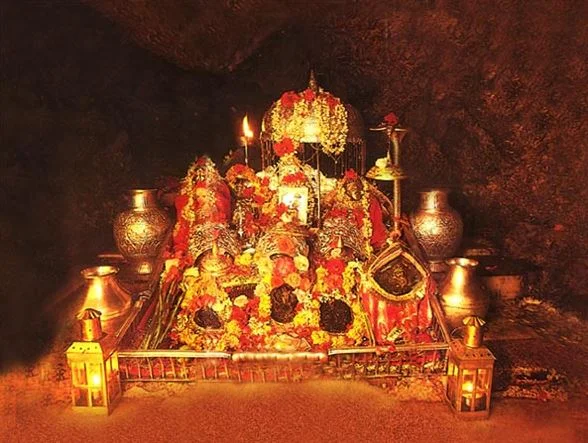
According to Hindu mythology, Mata Vaishno Devi is an incarnation of the goddess Durga.
It is believed that she took birth to annihilate the demon Mahishasura, who was tormenting the gods.
According to an ancient legend,
- Mata Vaishno Devi traces back to ancient times when she was born to Ratnakar and Dharshana, a deeply devout Brahmin couple.
- Even as a child, Vaishno Devi displayed a profound inclination towards spiritual practices, dedicating most of her time to meditation and prayer.
- One fateful day, she made the decision to leave her home and embark on a profound journey into the depths of the mountains, driven by her quest for enlightenment.
- During her arduous journey, she encountered a formidable demon named Bhairon Nath, who relentlessly pursued her.
- In order to escape from his clutches, Vaishno Devi sought refuge inside a cave and meditated there for a duration of nine months.
- This very cave, now renowned as the Vaishno Devi Cave, is believed to be the sacred site where she achieved enlightenment.
The pilgrimage is known for its spiritual significance and is considered a journey to seek the blessings and divine grace of the goddess.
The goddess resides in a cave within the Trikuta Mountains, where she performed penance and attained spiritual enlightenment.
Devotees believe that Mata Vaishno Devi fulfills their desires and grants them spiritual liberation.
3. Where is Vaishno Devi exactly Located?
Mata Vaishno Devi is located in the state of Jammu and Kashmir, near the town of Katra.
Katra serves as the base camp for the pilgrimage, situated around 42 kilometers (26 miles) from Jammu, the nearest major city.
The shrine is nestled amidst the scenic beauty of the Trikuta Mountains, offering breathtaking views of the surrounding valleys and hills.
Katra is well-connected by road and rail, and the nearest airport is in Jammu, which is approximately 50 kilometers (31 miles) away.
Various modes of transportation, including buses and private taxis, are available to reach Katra.
4. Vaishno Devi Route Map
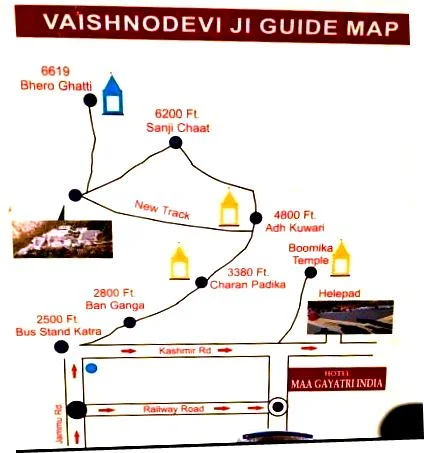
The pilgrimage to Mata Vaishno Devi involves a trek of approximately 13 kilometers (8 miles) from Katra to the shrine.
The trek passes through a well-paved and well-lit path, offering a comfortable journey for devotees.
Ponies and palanquins are available for those who prefer not to walk the entire distance.
The route is divided into different segments, including Banganga, Charan Paduka, Ardhkuwari, and Sanjichhat.
The entire trek is adorned with beautiful landscapes, natural beauty, and spiritual serenity.
5. Banganga River in Vaishno Devi
Banganga is the first significant stop on the trek to Mata Vaishno Devi, located around 1.5 kilometers from Katra.
It is believed that Mata Vaishno Devi quenched her thirst at this spot, creating a water source.
Devotees often take a dip or sprinkle the holy water of Banganga on themselves before continuing the journey.
The area around Banganga is adorned with temples, ashrams, and facilities for refreshments and rest.
6. Charan Paduka in Vaishno Devi
Charan Paduka is another important point on the trek, situated around 2.5 kilometers from Banganga.
It is believed that Mata Vaishno Devi stopped at this spot to rest, leaving her footprints on a rock.
The rock formations resembling the footprints of the goddess are worshipped by devotees.
The picturesque surroundings offer panoramic views of the valley, adding to the spiritual experience of the pilgrims.
Many pilgrims take a brief halt at Charan Paduka to pay their respects and seek blessings.
7. Ardhkuwari in Vaishno Cave
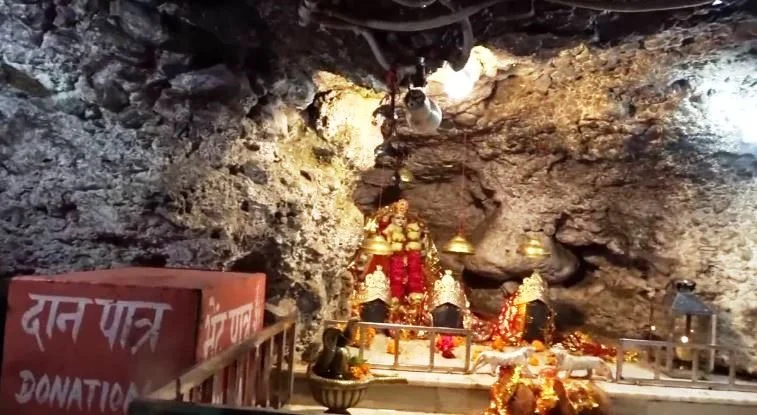
Ardhkuwari is a significant milestone on the trek, located around 6 kilometers from Charan Paduka.
- It is known for the holy cave where Mata Vaishno Devi meditated for nine months.
- The cave has a narrow passage known as the “Garbh Joon,” which symbolizes the womb.
- Devotees crawl through this passage as an act of penance and devotion.
Inside the cave, the goddess is worshipped in the form of Pindis (natural rock formations).
8. Sanjichhat in Vaishno Devi
Sanjichhat is the final stop before reaching the shrine, situated around 3 kilometers from Ardhkuwari.
- It is a resting point where pilgrims can take a break and rejuvenate themselves before the final ascent.
- Sanjichhat offers beautiful views of the valley and the Trikuta Mountains.
- Facilities such as restrooms, refreshment stalls, and accommodation options are available for pilgrims.
From Sanjichhat, the shrine can be reached by climbing a flight of around 700 steps or by taking a ropeway.
9. Bhawan, Katra, Jammu
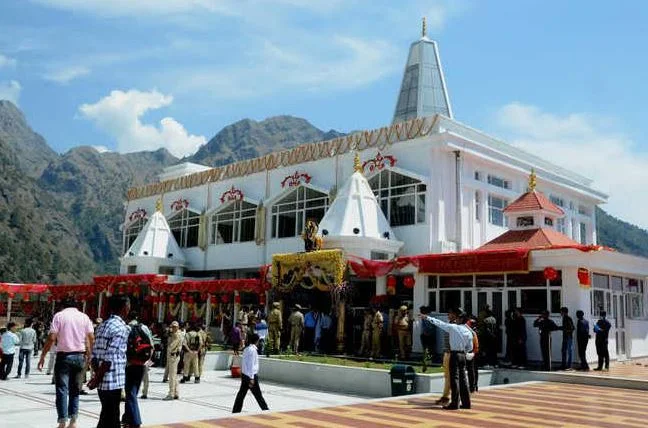
Bhawan is the holy shrine of Mata Vaishno Devi, located at the culmination of the trek.
It is situated in a cave within the Trikuta Mountains, at an altitude of around 5,200 feet.
The cave houses three natural rock formations called pindis, symbolizing the three forms of the goddess: Maha Kali, Maha Lakshmi, and Maha Saraswati.
Devotees offer prayers, perform rituals, and seek blessings from the divine mother.
The sanctum sanctorum is adorned with intricate carvings and decorations.
10. Darshan and Pooja Facts of Vaishno Devi
Devotees can have a darshan (sight) of Mata Vaishno Devi at Bhawan. The darshan is a moment of divine grace and spiritual connection for the devotees.
The rush for darshan can be quite high during peak pilgrimage seasons, and devotees may need to wait in queues.
Special poojas and aartis (rituals) are performed at specific times of the day.
- The Vaishno Devi Temple does not have specific opening and closing times, and this applies to the timings of Vaishno Devi in Jammu as well.
- Aarti ceremonies at the temple are held daily between 5:00 am to 12:00 pm and again from 4:00 pm to 9:00 pm.
Devotees can participate in these rituals and experience the divine energy of the goddess.
11. Bhairon Temple in Katra
After visiting Bhawan, many devotees also visit the Bhairon Temple, situated about 2.5 kilometers from the shrine.
It is believed that the pilgrimage to Mata Vaishno Devi is incomplete without seeking the blessings of Bhairon Nath, a fierce form of Lord Shiva.
The temple is located atop a hill, and pilgrims need to climb a steep path to reach it.
The surroundings offer breathtaking views of the valley, and the temple provides a peaceful ambiance for devotees.
Many devotees include a visit to the Bhairon Temple in their itinerary to complete the spiritual journey.
12. Katra Market
Katra, the base camp for the Vaishno Devi pilgrimage, has a bustling market that offers a wide range of religious and souvenir items.
The market is filled with shops selling pictures, idols, books, and other religious artifacts related to Mata Vaishno Devi.
Devotees can also find traditional clothing, jewelry, and handicrafts, reflecting the local culture and traditions.
The market is a popular spot for pilgrims to shop for souvenirs and keepsakes to commemorate their visit.
It also offers various food stalls and restaurants where visitors can enjoy local delicacies and refreshments.
13. Aarti Timings Facts About Vaishno Devi
The shrine of Mata Vaishno Devi is a site of numerous religious festivals and aartis throughout the year.
Special aartis are performed during important Hindu festivals such as Navratri and Diwali.
The aartis involve the chanting of hymns, rhythmic music, and the lighting of lamps and incense.
Devotees gather in large numbers to witness these divine rituals and seek blessings during festive occasions.
The atmosphere during these festivals and aartis is vibrant and filled with devotional fervor.
14. Helicopter Services in Vaishno Devi
To facilitate the pilgrimage, helicopter services are available for devotees who prefer a faster and more convenient mode of transport.
Helicopters operate between Katra and Sanjichhat, significantly reducing travel time.
The helicopter ride offers panoramic views of the mountainous landscape, adding to the overall experience.
It is advisable to book helicopter tickets in advance, as they can be in high demand during peak pilgrimage seasons.
The helicopter services provide an alternate option for those who may have physical limitations or time constraints.
15. Hotels in Vaishno Devi
Katra offers a range of accommodation options for pilgrims visiting Mata Vaishno Devi.
There are various hotels, guesthouses, and Dharamshala (pilgrim shelters) available to suit different budgets and preferences.
Some accommodations are located near the starting point of the trek, providing easy access to the pilgrimage route.
Many accommodations offer comfortable amenities such as clean rooms, attached bathrooms, and room service.
It is advisable to book accommodations in advance, especially during peak seasons, to ensure availability.
16. Vaishno Devi Trek Distance and Timing
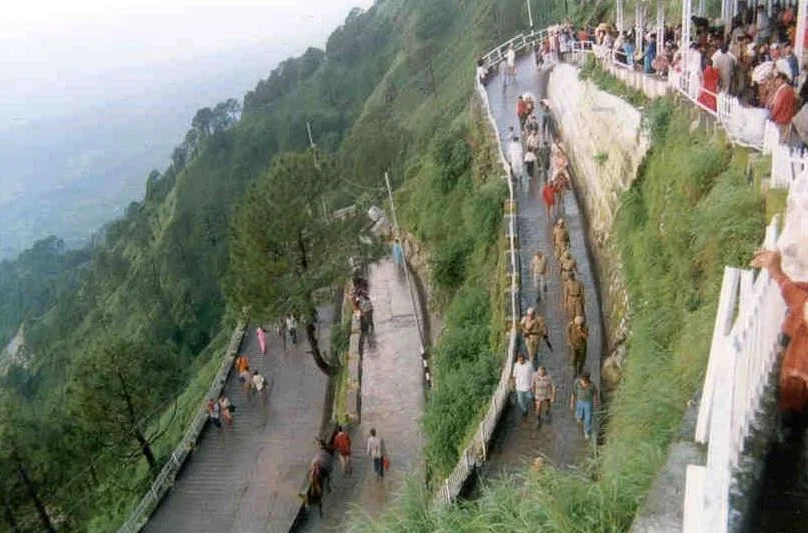
To reach the Vaishno Devi shrine, visitors embark on a trek of about 13 kilometers from Katra. The journey involves a steep climb and takes approximately 6 hours to complete.
Alternatively, devotees can avail themselves of various transportation options like ponies, palanquins, and helicopter services.
- The average duration of the Mata Vaishno Devi pilgrimage is around 6 to 8 hours, depending on the pace of the devotee.
- Some pilgrims complete the trek in a shorter time, while others prefer a more leisurely journey.
- The trek can be challenging for individuals with physical limitations or health conditions, and it is advisable to consult a doctor before embarking on the pilgrimage.
- Devotees can choose to start the trek at any time of the day, as the path is well-lit and open 24 hours.
Medical facilities are available along the trekking route and at Bhawan for any emergency or medical assistance.
It is recommended to avoid trekking during extreme weather conditions or at night for safety reasons.
17. Weather in Mata Vaishno Devi (Jammu)
The weather and climate around Mata Vaishno Devi can vary throughout the year.
- Summers (April to June) are generally hot, with temperatures ranging from 20 to 40 degrees Celsius (68 to 104 degrees Fahrenheit).
- Monsoons (July to September) bring heavy rainfall, making the trek path slippery and challenging.
- Winters (October to March) can be extremely cold, with temperatures dropping below freezing point.
It is advisable to check the weather forecast and dress accordingly, carrying warm clothing during winters and rain gear during monsoons.
18. Vaishno Devi Height
Vaishno Devi Temple is situated at a height of around 1,570 meters (5,180 feet) above sea level.
Mata Vaishno Devi Shrine offers a breathtaking setting for spiritual seekers.
The shrine holds immense significance for devotees who believe that seeking the blessings of Mata Vaishno Devi fulfills their desires and brings them peace, prosperity, and spiritual enlightenment.
19. Vaishno Devi Yatra Registration Online
To manage the influx of pilgrims, an online registration system is in place for the Mata Vaishno Devi Yatra.
Devotees need to register themselves on the official website or through the designated mobile app before undertaking the pilgrimage.
The registration process requires providing personal details, preferred dates, and the number of accompanying individuals.
Online registration helps in ensuring a smooth and organized flow of pilgrims and facilitates better crowd management.
Vaishno Devi Registration Online Here
20. Horses and Palanquins
For those who find it difficult to trek the entire distance, horses and palanquins (carried by porters) are available for hire.
Horses provide a faster mode of transportation, while palanquins offer a comfortable way to travel without physical exertion.
The charges for hiring horses or palanquins are fixed by the administration, and it is advisable to negotiate the price beforehand.
It is important to ensure the well-being of the animals and follow the guidelines provided by the authorities while using these services.
Pilgrims can hire horses or palanquins from the authorized counters at Katra or other designated points along the trek.
21. Festivals and Navratri in Katra, Jammu

The festival of Navratri holds special significance for Mata Vaishno Devi devotees.
Navratri, meaning “nine nights,” is a Hindu festival dedicated to the worship of the goddess Durga.
The festival is celebrated twice a year, in the months of Chaitra (March/April) and Ashwin (September/October).
The atmosphere is vibrant, with devotional songs, dances, and processions being organized by the pilgrims.
The peak pilgrimage season coincides with festivals and the auspicious nine-night celebration of Navratri.
I hope you liked these interesting facts about Vaishno Devi temple. you may also read more facts about other temples as well.
Related Posts
- 19 Facts About Amarnath
- 21 Facts About Kedarnath
- 27 Facts About Badrinath
- 16 Facts About Gangotri
- 17 Facts About Yamunotri